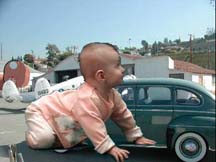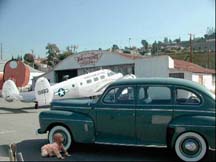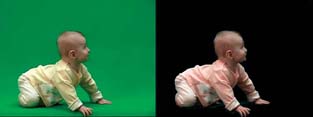Hack 70. Composite a Green Screen Image
| < Day Day Up > |
|
Green-screen compositing allows you to create Hollywood-style effects. Have you ever wanted to fly a spaceship? Or wanted to travel to Russia? Maybe you've just wanted to be a professional weatherman [Hack #62]. Whatever your dream, you can probably make it happen by using a green screen [Hack #14]. The movie Forrest Gump used green-screen techniques successfully to create the illusion of Tom Hanks' character (Forrest) meeting historical figures such as John F. Kennedy, Richard Nixon, and Elvis Presley. By recording your scene in front of a green screen [Hack #22] you can create almost any illusion you can dream up [Hack #67]. In addition to green-screen footage, you should also acquire footage you would like to composite it with. For example, in the case of meeting a historical person, you would want footage of that person. Before shooting your green screen, make sure you know what footage will be in the background of your shot. Figure 6-35 shows a frame from a green-screen shoot and a background image for compositing. Figure 6-35. Two images that will soon become one 6.11.1. Starting the CompositeCompositing your footage requires you to use a key effect, which allows you to remove certain colors or portions of the video signal, such as luminance, from your final image. When using a key and multiple layers of video, the layer below the one that is keyed will show through. Figure 6-36 shows a green-screen image with and without a key applied. Here's how to apply a green-screen key:
If you find that the specific key effect you have used doesn't work as well as you expected, you can try other key effects, such as like Color Key, Chroma Key, or RGB Key. Figure 6-37 shows how an initial composite might look. Figure 6-37. Merging the two images in an initial composite Unless you're really lucky (or really good), you will have to change the position of your actors within the frame. 6.11.2. Shifting the ShotThe next step in compositing your shot involves moving it to the location you desire. By moving the center point of the footage, you can change your actors' spatial relationship to the rest of the scene. This effectively enables you to place your actors in a more believable position.
Changing the position of your video is really a matter of trial and error. It might take you a short time to get the video to where you want it. Once you've placed your video, either play it (if your system is capable of real-time playback) or spot-check it by clicking in various places on your timeline. If there is a lot of movement in your green-screen image, you might need to reposition your video until it looks right. Figure 6-38 shows the composite after repositioning the green-screen image. Figure 6-38. Moving the center of the image Again, unless you're really lucky, you will need to make a few more adjustments in order to fool your audience into believing their eyes. 6.11.3. Adding the Finishing TouchesDepending on how you have lit your green screen, the colors and shadowing of your background, and the overall match of your footage, you might need to apply additional effects to achieve any level of realism. Some effects you might have to work with include saturation/desaturation, brightness and contrast, and general color levels. If you are comfortable using color correction, that will be your most powerful tool. Additionally, if there are shadows in your background, you might want to add shadows [Hack #71] to the green-screen image to match. Figure 6-39 shows the image after slightly desaturating it and adjusting and the brightness and contrast. Figure 6-39. Altering the saturation, brightness, and contrast Getting a green screen to achieve a level of believability can take a long time. When working with the footage, you should take a break and walk away at least every hour. Otherwise, you might become too engrossed in the effect to think about it clearly. |
| < Day Day Up > |
EAN: 2147483647
Pages: 158
 Effects Palette
Effects Palette 